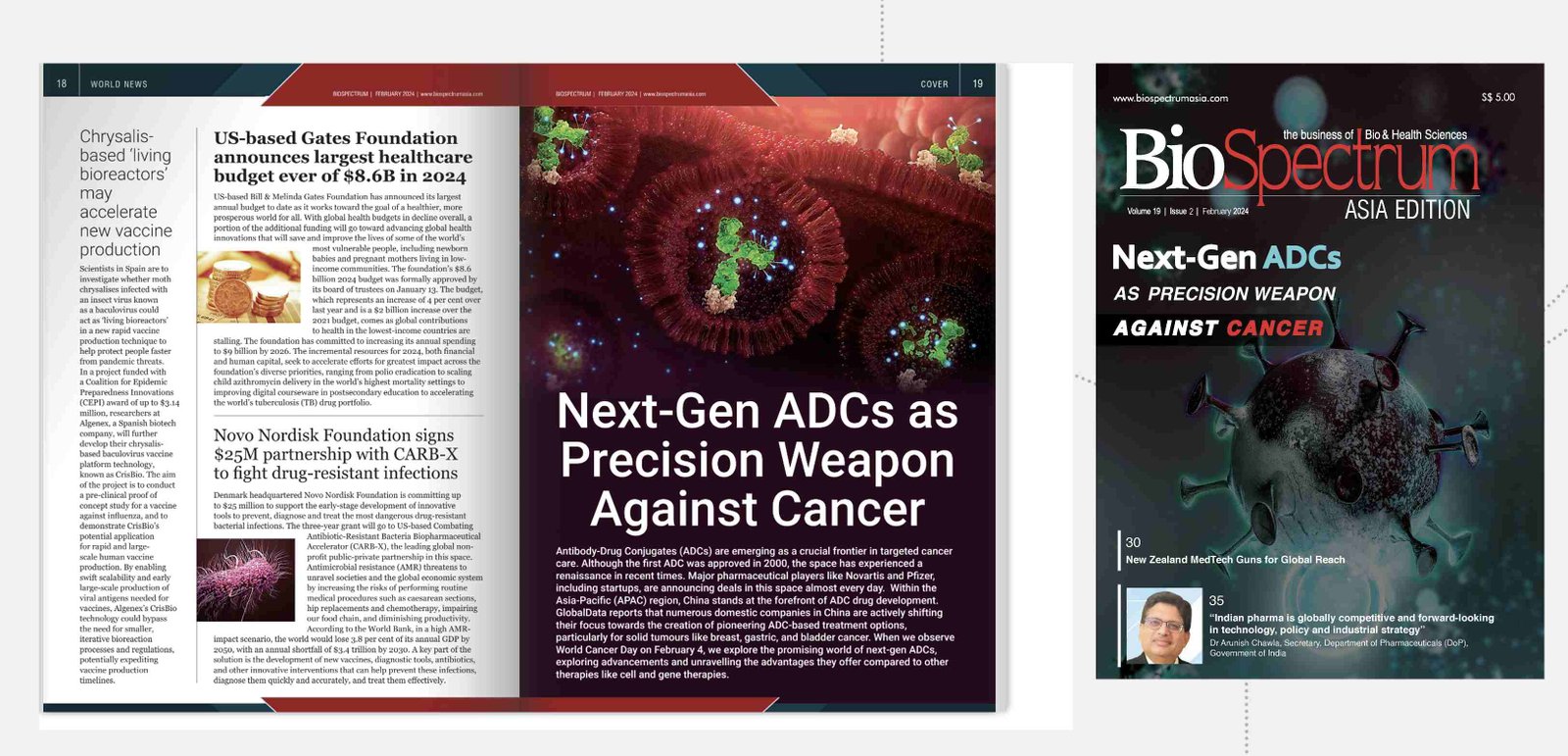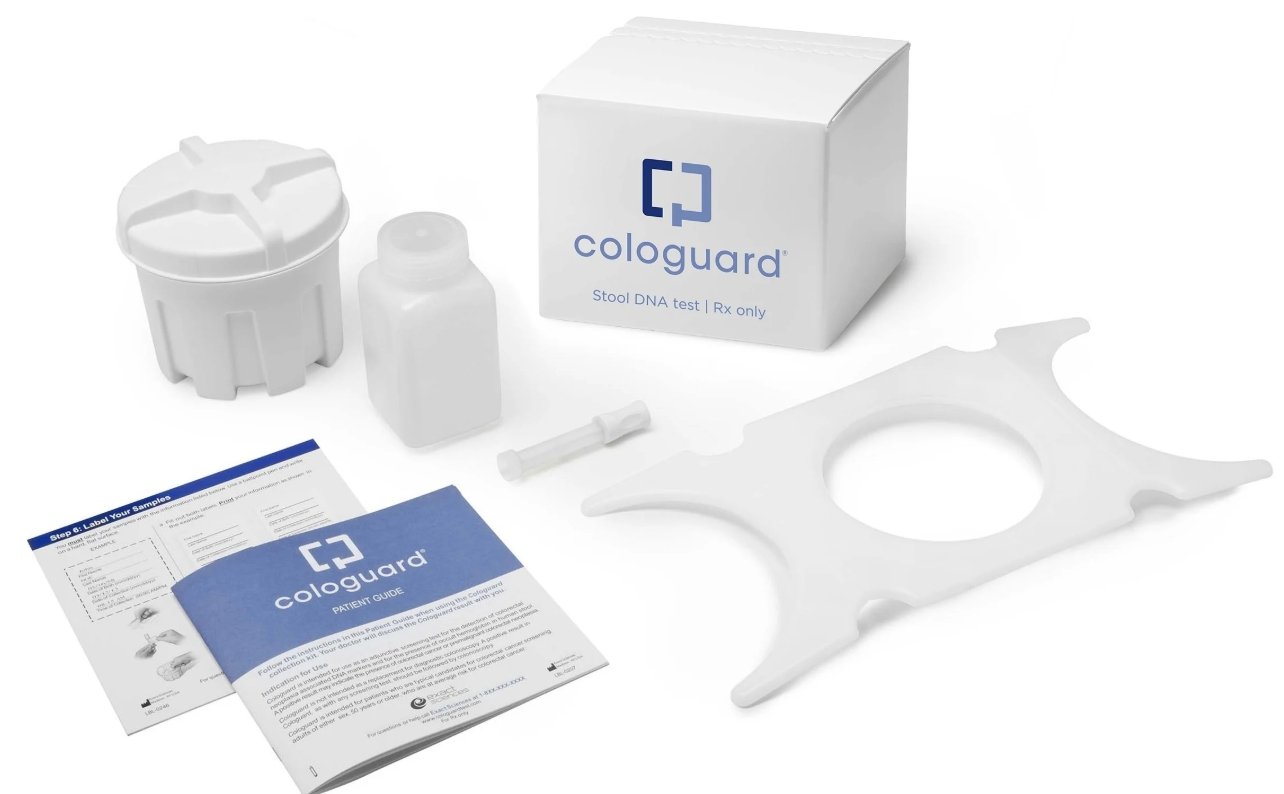
Cancer poses a significant challenge for the pharmaceutical industry, driving a constant search for improved oncology drugs. The industry has now put the spotlight on antibody-drug conjugates (ADCs), representing a promising frontier in targeted cancer treatment. 2023 was a big year for ADCs, marked by a total of 76 deals (by December 26, 2023) encompassing licensing agreements, collaborations, and acquisitions.
Majority of the big pharma companies have either announced acquisitions or partnership with smaller biotech companies in this space, the latest entrant is Johnson & Johnson (J&J) which on January 8, 2024, made a significant move with a $2 billion acquisition of ADC developer Ambrx Biopharma, bolstering its ADC pipeline. Just a few weeks back, on December 26, 2023, J&J sealed a substantial $1.7 billion deal with South Korea's LegoChem Biosciences for the development and commercialisation of LCB84, a promising Trop2-directed ADC. The preclinical data for LCB84 highlighted a distinct safety and efficacy profile across various cancers, underlining the significance of these strategic advancements in the ADC landscape.
China is making significant strides in the ADC sector, riding the partnership wave with major pharmaceutical companies. Bristol Myers Squibb, in collaboration with SystImmune, entered an exclusive agreement to jointly develop and commercialise BL-B01D1, an innovative EGFRxHER3 bispecific ADC. SystImmune is spearheading efforts in mainland China, while Bristol Myers Squibb oversees developments elsewhere. GlaxoSmithKline (GSK) strategically fortified its oncology portfolio by acquiring Hansoh Pharma's gynaecologic cancer candidate (HS-20089), showcasing a commitment to addressing specific cancer types.
In a clinical trial collaboration agreement, Eisai and China-based Bliss Biopharmaceutical partnered for BlissBio's ADC candidate targeting Human Epidermal Growth Factor Receptor 2 (HER2) in cancer treatment. AstraZeneca joined the ADC surge with the acquisition of China-based LaNova Medicines, gaining access to LaNova Medicines' preclinical candidate LM-305, focused on relapsed and refractory multiple myeloma.
Shanghai-based DualityBio, a clinical-stage company, stands out for its cutting-edge ADC technology platform. The firm is emerging as a fan favourite with both big pharma and local firms. In April, last year DualityBio made headlines by selling two ADC assets to the German mRNA giant BioNTech for an upfront payment of $170 million. Building on this achievement, the collaboration between DualityBio and BioNTech expanded in August to globally advance, manufacture, and commercialise a third ADC candidate, DB-1305.
Strengthening its position, DualityBio entered into an agreement with BeiGene in July 2023, granting BeiGene an exclusive option for a global clinical and commercial licence for an investigational preclinical ADC therapy targeting specific solid tumours. In October, DualityBio further solidified its standing by securing global out-licensed rights from local firm MediLink Therapeutics for their ADC targeting HER3.
One of the major highlights in this space was Pfizer's $43 billion acquisition of Seagen. Seagen is a pioneer in ADC technology, with four of the 12 total FDA-approved and marketed ADCs using its technology industry-wide. Another noteworthy deal in this space is AbbVie’s proposed $10 billion deal to acquire ImmunoGen, and its flagship cancer therapy ELAHERE (mirvetuximab soravtansine-gynx), a first-in-class ADC approved for platinum-resistant ovarian cancer (PROC). The acquisition accelerates AbbVie's commercial and clinical presence in the solid tumour space.
American pharma major Eli Lilly made two acquisitions in this space last year. In October 2023, the firm acquired French biotech Mablink Bioscience, a pre-clinical biotechnology company pioneering the development of next-generation ADCs via its PSARLink proprietary platform for an undisclosed amount. In June 2023, the firm had acquired ADC developer Emergence Therapeutics for $7 million.
Another noteworthy collaboration was between Daiichi Sankyo and Merck. The two pharma majors formed a global collaboration for three DXd ADC candidates: HER3-DXd, I-DXd, and R-DXd. This partnership entails joint development and potential worldwide commercialisation, excluding Japan where Daiichi Sankyo retains exclusive rights.
This is proving to be a lucrative period for ADC developers, benefiting from a surge in deal-making. ADC companies are becoming prime targets for private equity and venture capital investment. EY Life Sciences reports that a substantial 52 per cent of private equity and VC investment in the first quarter of 2023 was directed towards emerging treatment modalities, encompassing ADCs, gene therapies, and peptides.
Asian scenario
The region has also witnessed a flurry of activities. 2024 started with Roche’s billion dollar licensing agreement with Chinese startup MediLink Therapeutics regarding its lead candidate YL211, targeting c-Mesenchymal epithelial transition factor (c-Met) against solid tumours. South Korea’s LegoChem Biosciences, which has previously inked a pact with J&J secured KRW 550 billion from Orion to become a global ADC powerhouse. Singapore based Hummingbird Bioscience licensed its HER3-ADC, HMBD-501, to Endeavor BioMedicines for up to $430 million in milestone payments. Takeda, the Japanese pharma majors secured exclusive global rights from Innate Pharma for ADCs targeting celiac disease.
Major contract research development and manufacturing organisations (CDMO) in the region are taking initiatives to ramp the production and manufacturing of ADCs.
Samsung Biologics is intensifying its ADC production efforts with strategic investments. The firm has invested in Araris Biotech AG, a leader in proprietary ADC-linker technology. The firm has also partnered with AimedBio after an investment by Samsung Biologics joined an equity investment in AimedBio, a Korean biotech company. WuXi Biologics from China has also announced plans to spin off its ADC operation.
LOTTE BIOLOGICS, based in South Korea, is actively pursuing partnerships and initiatives to establish itself as a prominent player in the ADC sector. With an ongoing ADC facility expansion in Syracuse, USA, the company aims to offer services spanning the entire ADC value chain, from product development to commercial production, leveraging its platform technology.
Why are ADCs becoming popular ?
The first ADC drug, Pfizer's Mylotarg, received United States Food and Drug Administration (US FDA) approval in 2000. However, it was withdrawn from the market in 2010 due to toxicity concerns raised in a post-marketing trial. In 2017, Mylotarg was reintroduced at a lower dose for a specific subset of leukaemia patients, following FDA clearance. The next ADC, Seagen's Adcetris, reached the market after an 11-year gap.
The list of FDA-approved ADCs has rapidly expanded in recent years, with eight products gaining approval between 2019 and 2022. Currently, a total of 13 drugs have received approval so far. It is worth noting that some of these treatments, like Roche's Kadcyla (trastuzumab emtansine) and Daiichi Sankyo/AstraZeneca's Enhertu (trastuzumab deruxtecan), have swiftly evolved into blockbuster successes for their respective owners.
The overall pipeline of clinical prospects is growing, there are approximately 100 ADC candidates now in clinical development and well-over 150 candidates in preclinical development. (Source: Wuxi Biologics). Analysing data from 2022, Beacon Intelligence’s analysis found that the number of new ADCs entering the clinic had doubled compared to 2021. A large amount of this research was emerging from the US, but when Asian countries were grouped together, the amount of clinical assets being developed there outnumbered those in the US.
IQVIA’s 2023 report on global oncology trends also outlined that R&D growth into solid tumour research is a major focus across the industry, and ADCs are becoming a larger part of this research. This is due to ADC clinical prospects being concentrated on solid tumour targets, with 65 per cent growth over the last five years in assets in the area.
While most approved ADC therapies have targeted liquid cancers, the focus is now shifting towards solid tumours. Here is an insight into why there's a sudden interest and outpouring of billions of dollars into this space.

“While ADCs have been in use since their first approval in 2000, the recent surge in interest can be attributed to the substantial increase in approvals, with more than half of the 13 total approvals occurring in the last three years. This trend is expected to continue, as Daiichi’s Anti-Trop2 ADC is anticipated to join the market in 2024. The growing number of approvals has prompted many pharmaceutical companies to want to further explore the potential applications of ADCs in various oncology indications and enhance their efficacy. This heightened interest aligns with the maturity of current ADC technology platforms, reflecting decades of research and technological advancements in every component of ADCs. Clinical trials demonstrating the safety and efficacy of ADCs across a range of cancer indications have further strengthened their appeal, particularly in addressing previously hard-to-treat solid tumours,” said Dr Christian Rohlff, CEO of Oxford BioTherapeutics, UK.
Oxford BioTherapeutics (OBT) is a clinical stage oncology company with a pipeline of first-in-class ADCs, with its lead asset, OBT076 currently in Phase 1b clinical trials. A further nine programmes are in preclinical development in partnership with ImmunoGen.
When a cytotoxic drug is delivered to a tumour cell as an antibody-drug conjugate, its effectiveness increases by several logs than if it were to act alone on cancer cells. Over the last decade or so, ADC technologies have evolved substantially from initially first-generation molecules where the cytotoxic payload is randomly attached to the targeting antibody and the resulting drug product is rather heterogeneous and unstable to second or even third generation ADCs where cytotoxic payload conjugation is site-specific and much more stable.
“As a consequence, today’s ADC molecules are showing a much improved pharmacokinetic and stability profile, resulting in a substantially widened therapeutic window. To date, approximately one third of all antibody-based therapeutics in clinical development are ADCs (roughly 350), and there are 13 ADCs approved by the US FDA for treating various haematological and solid cancers. At this point in time the field is rapidly progressing, exploring immune-stimulating ADCs, protein-degrader ADCs, conditionally active ADCs, or even bispecific ADCs and dual-payload ADCs, to tackle challenges such as tumour heterogeneity or evolving resistance to ADCs. Beyond its use in oncological indications, ADCs are starting to show great potential in non-oncological indications including, but not limited to metabolic and immunological diseases,” said Dr Martin Steegmaier, Chief Scientific Officer, SOTIO Biotech, Czech Republic.
SOTIO is developing the next generation of potent immunotherapies for patients with cancer.
Echoing the similar sentiments, Dr Jerome Boyd-Kirkup, Chief Scientific Officer, Hummingbird Bioscience said “ADCs are a treatment modality that aims to deliver a cytotoxic drug payload specifically to tumour cells. Over the last couple of years ADCs have demonstrated very compelling clinical benefits. This benefit has been enabled by technological advancements that have established the right balance between safety and efficacy for the drug that is conjugated to the tumour targeting antibody, as well as by improvements to the stability of the linker that joins the drug to the antibody. For the realisation of the broad promise of ADCs, it is critical that the ADC targets a highly tumour-specific antigen, such as HER2 or HER3, and does not inadvertently attack non-cancer cells. Given the early successes in a few types of cancer there is great interest in finding target antigens for more cancers as well as in engineering better ADC molecules that can benefit more patients.”
Singapore based Hummingbird Bioscience is at the forefront of engineering new ADCs for a variety of cancers, leveraging our capabilities in rational discovery of optimal tumour targeting antibodies, coupled with our innovations in new payloads and linkers.
Magic bullets for targeted cancer therapies?
Paul Ehrlich envisioned ADCs with the concept of a ‘magic bullet’ developed in 1907 and yet the first ADC was only approved in 2000. Since then, a steady increase in clinical studies for new ADCs has been observed leading to the emergence of new compounds capable of improving treatment outcomes for patients with various cancer types.
“When Paul Ehrlich, the famous German Nobel Prize laureate, postulated the concept of the ‘Magic Bullet’ more than 100 years ago, conceptually he likely envisioned some wonder drug pretty close to what is administered today as an ADC to patients in need. In comparison, cellular therapies or other gene therapies have an equally high potential to revolutionise today’s treatment paradigms or already have shown amazing responses particularly in patients treated for haematological malignancies. In contrast, the field of cellular therapies still awaits a breakthrough when it comes to treating solid cancers. Remarkably, today’s approved ADC therapies are showing game changing clinical activity particularly in the solid cancer indications. Both modalities have equally high potential to contribute to significant patient benefit but cellular or CART cell therapies have yet to establish themselves as approved drug regimens in the solid cancer indications where we still face a particularly high medical need. In addition, ADCs are “off-the-shelf” therapies readily available to a large patient population. In the cellular therapy space, logistical and production challenges and certainly also cost and time-to-treatment constraints still need to be tackled or improved,” said Dr Steegmaier.
Cancer includes a very complex set of different diseases and fortunately many technologies are competing to develop new approaches to treat each of these diseases.

“ADCs developed to deliver extremely potent toxins against tumours have now proven to be valuable therapies. We also are seeing an expansion of their role as they have a cost advantage over very complex, more expensive therapies. We are also observing a very wide diversity of antibody conjugates capable of recognising more than one target or being able to deliver molecules with more specific mode of action in the tumour. There is a lot of hope that next generation ADCs will one day deliver treatment that will change the lives of people facing cancer,” said Dr Léo Marx, Medicinal Chemist, Bioconjugates Manager, Debiopharm, Switzerland.
Debiopharm is an independent biopharmaceutical company with an ongoing commitment to develop tomorrow’s standard of care to cure cancer and infectious diseases and improve patient quality of life.
Furthermore, ADCs are antibody targeted chemotherapeutic molecular entities meaning they are generally well tolerated by patients. Notably, ADCs don’t encounter some of the efficacy challenges faced by cell therapies in treating solid tumours.
“ADCs are a modality that are much more accessible to develop and manufacture versus cell and gene therapies. At their heart they leverage the advantages of two very well known drug classes – the safety and exquisite targeting ability of antibodies as well as the tumour killing properties of chemotherapy drugs. Cell and gene therapies are more time- and cost-intensive, and require specialised facilities for patients. With these considerations, ADCs may benefit more patients than cell and gene therapies,” said Dr Jerome Boyd-Kirkup.
Are ADCs truly the golden ticket to targeted cancer therapies. In 2022, cell and gene therapies dominated the scene and continue to be integral to pharma. Now, the industry is shifting focus to develop more cutting-edge and inventive therapies. Do ADCs offer a better alternative to treatments like cell and gene therapies?
“Unlike CAR-T therapy, which remains an expensive and personalised treatment option, ADCs are an ‘off-the-shelf’; treatment, making them more widely available and cost effective. Engineered as targeted therapies, ADCs selectively kill tumour cells whilst sparing healthy tissues- a significant advancement compared to non-targeted approaches in many standard of care chemotherapy treatments. Multiple clinical trials have recently demonstrated efficacy and safety of a variety of linker payload combinations against a handful of tumour antigens. The next generation of ADCs, by applying validated ADC platforms against novel cancer specific antigens, have the potential to reach patients who currently have few treatment options. ADCs being a targeted therapy with an antibody linked to a cytotoxic payload, circumvent some of the efficacy challenges faced by cell and gene therapies. Notably, ADCs like Padcev for bladder cancer, Elahere for ovarian cancer, and Kadcyla, Trodelvy, and Enhertu for breast cancers have demonstrated significant efficacy in solid tumours.” said Dr Rohlff.
Recent safety concerns, including evidence suggesting that the long- term consequences of random viral gene integration could cause secondary cancers, have dampened the popularity of cell and gene therapies, shifting the interest to ADCs which have the potential to overcome many of these challenges. However, it's not the be-all and end-all for cancer; there are hurdles to overcome.
“While recent advances in ADCs have been revolutionary, further innovation is necessary. To date, around 90 per cent of cancer patients are either not eligible, or do not respond to existing ADC treatments, which all target the same pool of about 20 tumour antigens,” said Dr Rohlff.
But nonetheless, ADCs have offered a stronger hope that the elusive cure for cancer will finally be on the horizon.
The ADC market, valued at $9.7 billion in 2023, is expected to more than double, reaching $19.8 billion by 2028. The race is on to secure a significant share of this expanding market, making it an intriguing space to observe.
Ayesha Siddiqui




